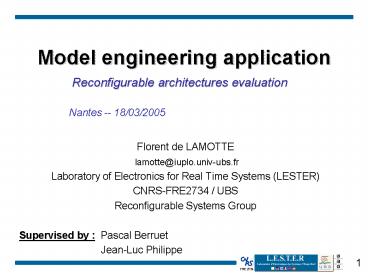Model engineering application - PowerPoint PPT Presentation
1 / 19
Title:
Model engineering application
Description:
Laboratory of Electronics for Real Time Systems (LESTER) CNRS-FRE2734 / UBS ... Eased evolution. AMMA. Rule based. Pluggable with the external world through projectors ... – PowerPoint PPT presentation
Number of Views:18
Avg rating:3.0/5.0
Title: Model engineering application
1
Model engineering application
Reconfigurable architectures evaluation
Nantes -- 18/03/2005
- Florent de LAMOTTE
- lamotte_at_iuplo.univ-ubs.fr
- Laboratory of Electronics for Real Time Systems
(LESTER) - CNRS-FRE2734 / UBS
- Reconfigurable Systems Group
- Supervised by Pascal Berruet
- Jean-Luc Philippe
2
Contents
- Overview
- Context introduction
- Domain semantics
- General Framework
- Implemented transformations
- Architecture Model
- Meta-Model
- Physical Architecture
- Criticality Analysis
- The OAG
- Criticality Evaluation
- Actual Implementation
- Demonstration
3
Context Introduction
- Reconfigurable Systems Group
- Discrete Event Systems (Manufacturing, ITS)
- Control and Supervision code generation
- Electronics use in Discrete Events Systems
- Electronic Systems
- Video and Signal processing applications
- FPGAs
- Reconfiguration
- Detecting when current config is not suitable
- Selecting a new configuration for the system
- Carrying on the transition
4
Domain Semantics
- Product processed part (or data)
- Function action made on a product
- Logical Operating Sequence sequence of
functions to obtain a product - Resource physical element of the system
- Operation implementation of a function on a
resource - Operating Sequence
- Architecture
- Physical
- Logical
- Configuration
- Physical
- Logical
5
Overview of the application
- Capturing the architecture of the system
- Analyzing the architecture (metrics)
- Dependability
- Performance
- Updating the model to enhance the architecture
6
General framework
Architecture model
7
Implemented Transformations
Architecture model
Criticality Evaluation
Criticality report
8
Architecture Model
Architecture model
Criticality Evaluation
Criticality report
9
Architecture Meta-Model
0..
FunctionSequence
ordered
1..
ParameterizedFunction
Product
0..
0..
Function
LogicalArchitecture
0..
PotentialOperation
Architecture
0..
Resource
PhysicalArchitecture
TransportResource
StationaryResource
0..
0..
0..
from
0..
0..
Connection
Port
to
0..
10
Physical Architecture in UML
11
Criticality Evaluation
Architecture model
Criticality Evaluation
Criticality report
12
Criticality Evaluation
- Objective
- Find the tolerance of the system towards the
failure of some of its elements. - Elements are removed from the architecture and
non available functions (directly or indirectly)
of the system are listed
13
Criticality Evaluation
Architecture
Description Model
OAG Building
OAG for Architecture
Analysis Model
Criticality computation
Criticality Report
Report Model
14
An analysis model the OAG
Architecture
OAG Building
M1 Active stocking and (Non Machining or O1 (M1,
F1) or O3 (M1, F2))
INM1 INM1/R
OAG for Architecture
IN Active stocking and Non Machining
M1OUT M1OUT/R
M1M2 M1M2/R or M1M2/Cv
Criticality computation
M2M1 M2M1/R
INM2 INM2/R
Criticality Report
OUT Active stocking and Non Machining
M2 Active stocking and (Non Machining or O2 (M2,
F1) or O4 (M2, F3))
M2OUT M2OUT/R
15
An analysis model the OAG
Architecture
OAG Building
OAG for Architecture
Criticality computation
Criticality Report
16
Criticality computation from OAG
Architecture
OAG Building
OAG for Architecture
Criticality computation
Criticality Report
17
Actual Implementation
- For performance considerations
- Incidence matrixes are extracted from the OAG
- Accessibility matrixes are calculated from
incidence matrixes with ad-hoc tool - Results are reported in a pdf file (using LaTeX)
18
Demonstration
19
Conclusion
- Model Engineering
- Forces good domain definition
- Automation for model management
- Consistency between models
- Eased evolution
- AMMA
- Rule based
- Pluggable with the external world through
projectors - Evolutions of the application
- Implement architecture model refinement
- Add other metrics
- Take configurations into account































